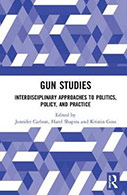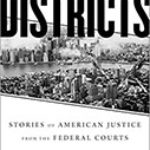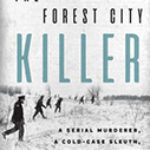Gun Studies: Interdisciplinary Approaches To Politics, Policy, And Practice

Editors: Jennifer Carlson, Kristen A. Goss, & Harel Shapira
Publisher: London; New York: Routledge, 2019. 356p.
Reviewer: Joshua D. Behl │ July 2020
Gun Studies: Interdisciplinary Approaches to Politics, Policy, and Practice is an interdisciplinary collaboration of authors from various fields of interest to guns – including Criminology, Marketing, Political Science, Law, and Sociology. The book claims to be less about the relationship between guns and crime and focuses more on “empirical and theoretical understandings of how people live with, experience, and think about guns in their day-to-day lives” (p. 1). However, the book does a better job of detailing the theoretical at the expense of the empirical. The book is divided into chapters that are cogently grouped together by theme.
Chapters 1-3 are all about the marketing and advertising element of gun sales. Specifically, in chapter 1, the authors, through content analysis, argue that gun advertisements have shifted from a primarily hunting theme to a theme more focused on self-defense in order to sell a wider range of guns. In chapter 2, the author argues that the gun industry sells fear of armed conflict with the only logical conclusion being to arm oneself to protect your family against dangerous criminals. In so doing, “owning a firearm becomes an act of love” (p. 42). In chapter 3, the author focuses her attention on the marketing strategies aimed at kids – specifically, the use of quotes and other marketing imagery that is purportedly derived from kids. While the author acknowledges that the gun industry is attempting to break into a new market to make more money, she also argues that the marketing is misleading as it is attempting to “nostalgically [reenact] a world that never was” (p. 62).
Chapters 4-5 of Gun Studies also fall under the “business” umbrella, but focus more on the actual gun market as opposed to specifically the advertising strategy used to sell guns. Chapter 4 is an empirical assessment of the illicit gun market in Los Angeles, California. The initial hypothesis was that since LA has such strict gun control regulations in place, guns were being imported from neighboring areas. This hypothesis was unsupported, as the majority of illicit guns were legally sold in LA and then sold/gifted to others. In chapter 5, the authors argue that “similar to businesses in other industries, manufacturers and retailers of firearms work closely with industry lobby groups to understand the diverse wants and needs of customers and shape policy that supports the industry’s ability to profitably satisfy current and potential customers” (p. 95). Specifically, the authors go into detail about the four categories of market research engaged in by the gun industry to ensure that sales continue to rise.
Chapters 6-10 shift the focus of the text from the business and marketing techniques of the gun industry to focus on the politics of gun ownership and gun control. The author of Chapter 6 argues that the strength of the NRA (as well as fear of the NRA) has led many politicians to back away from publically campaigning against gun control. This is largely because gun owners are quite passionate about their guns, and any threats to their gun rights are viewed as “dire” (p. 129). In chapter 7, the author argues that the gun control movement of the past two decades has been relatively weak because it, unlike the NRA and its supporters, lacks mass engagement, lacks media support for messaging, has supporters who do not like tepid actions for change, and because the framing of “gun control” has failed to garner wide spread support. However, the author is optimistic because the gun control movement has seen a resurgence of interest in the wake of several mass shootings causing the movement to be fundamentally changed in a way that may bring about true reform. The author of chapter 8 believes that if the gun control arguments were framed differently, there would be more widespread acceptance. For example, since party affiliation is a strong predictor of gun control attitudes, the arguments need to be taken out of party context and redirected toward a different identifier – gender, especially as it relates to domestic violence. The author found support for the idea that women viewed the domestic violence frame as more convincing than a more traditional gun control argument. In chapter 9, the author discusses Australia as an example for gun control working. That author suggests that this could happen in America, but also fears that America has “gone beyond the point of no return” (p. 184). Chapter 10 analyses guns as “signs,” or stand-ins, for much broader beliefs and issues that individuals perceive. Using psychoanalysis as a general framework, the author argues that guns are a prosthesis for extending and magnifying human efficacy in the world. Guns allow for a feeling of safety while also signifying a form of authority that some may find lacking.
Chapters 11 details an ethnography of a gunshot victim’s life and the issues that the victim suffers as a result of his wound. Chapter 12 extends the psychoanalytic theory by combining it with object relations theories to discuss how guns provide a way for men to show intimacy, including male relationships with their own fathers and grandfathers. The author makes the point that “the belief that someone might want to take their guns away is more than a fear of losing the privileges of manhood; it is also the fear of losing a thin, tenuous means through which men have created a bounded intimacy with fathers, sons, brothers, and other men” (pg. 231). Therefore, the removal of guns could easily lead to a removal of those bonds.
Chapters 13-15 explain the relationship between guns and the nation-state. In Chapter 13, arguably the best policy chapter in the text, the author discusses how we could use technology to enforce minor infractions, thereby removing an armed officer from a situation that could escalate into violence. By changing how police interact with the public, it could reduce the number of deadly shootings done by police and, importantly, of the police as well. Chapter 14 argues that there is a sort of “necropolitics” that takes place during natural disasters or looting scenarios that “appeal to the general welfare and safety while designating certain lives as disposable” (p. 258). This “DIY Security” allows for the white majority to use racially coded language to justify the killings of the “other” in society. Chapter 15 analyzes the gun violence problems that face Latin America. The author argues that “Latin Americans typically acquire guns in a context of state neglect, corruption, and illegitimacy” (p. 287). Basically, due to the lack of a legitimate, state sponsored security force, the population has to arm themselves for personal and property protection.
Chapters 16-18 are chapters that directly address the issues of firearms and violence. Chapter 16 analyzes the relationship between firearms and violent crime. Results indicate that while guns are used in a majority of murders, they are rarely used in other forms of Index Crimes (less than a third). Chapter 17 details how guns are related to suicide. In one of the most in-depth analyses in the book, author Gary Kleck argues that while it is true that suicide by gun is high, when you use proper control measures, suicide by gun is not significantly more dangerous or deadly than suicide by hanging. Basically, while it is true that fewer guns will reduce gun suicide, it is unclear whether the overall suicide rate will be affected in any measurable way. Chapter 18 offers the personal reflections of three major gun scholars. The scholars conclude that more guns do lead to more homicides, that the 2nd Amendment has had a long and winding legal history, with its interpretation changing with changing times, and that gun rights voters are single issue voters and therefore have more power than gun control advocates who typically find other issues more important when voting.
While this text does a good job of providing a wide overview from a variety of disciplines, depending on your academic training, you may find the book leaving you wanting. Itis long on theory but short on data. Having myself been imbued with a positivist philosophy, I believe the book would have benefited from more empirical work, rather than depending upon untested theoretical ideas. That being said, I believe that this book is ripe with research questions for those who are interested in the study of guns. There are clearly defined theories that are laid out and propositions suggested that provide fertile ground for researchers and policy makers to investigate.
Gun rights and gun control advocates would likely both agree with contributor Phillip Cook when he says that “the research results that have obtained the greatest visibility and public influence are not necessarily those that stand up well to scientific review and replication, but rather those that serve powerful ideological interests. In short, gun violence serves as a challenge to the very possibility of evidence-based policy making in a contentious arena” (p. 331). It is because of this that more research is critical to help answer questions about what is truly a life and death issue.
Joshua D. Behl, Assistant Professor of Criminology. Flagler College


